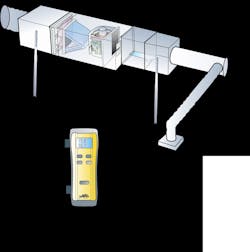Limitations of Dry Bulb Temperature Measurement
With summer around the corner, preparing for the changeover from the heating to the cooling season is a good idea. When the first heat wave hits, you will be bombarded with calls and focused on keeping up with the demand for your time. As you move from call to call, you need quick measurements to determine whether a system works acceptably. Many technicians use the dry bulb temperature drop (Δt) across the indoor coil as their indicator of choice.
We measure dry bulb temperatures in the cooling mode with a standard thermometer to interpret how much heat the HVAC system removes. However, many techs misapply these test results, take them out of context, or use them to make incorrect assumptions. Let's look at the proper application of dry bulb temperature, its limitations, and what you can add to it for real diagnostic value.
A Common Assumption
Many good techs assume that a system operating with a 16° to 20° F Δt across the indoor coil is good. However, they overlook a lot of variables and make assumptions because of this conclusion. This interpretation can easily fool you into thinking a system is problem-free.
Combine Fan Airflow with Dry Bulb Temperatures
One assumption is that the system has proper fan airflow if a 16° to 20° Δt exists. This assumption is often incorrect because many systems don't move enough airflow across the indoor coil. This problem won't show up in dry bulb temperature readings alone. You must take additional measurements to verify proper operation. Fan airflow is a handy measurement to combine with the dry bulb Δt to see the bigger picture.
When you measure sensible heat in the field, you can compare it against the manufacturer's engineering data for the current testing conditions.
The easiest and quickest way for most technicians to estimate fan airflow is to measure total external static pressure (TESP) and plot it on the manufacturer's fan performance table. This procedure gives you an idea of airflow moving across the coil. If the airflow is within the range of 350 to 400 cfm per ton, you're doing great. If not, there's work to do.
The Result is Sensible Heat
Once you combine fan airflow with dry bulb Δt, you will achieve a new level of understanding. The formula helps you determine how many Btus a cooling system removes and how well the equipment performs. These measurements are components of the sensible heat formula and will change how you look at an HVAC system forever.
There is a lot more to HVAC performance than you might think. That's because the equipment's yellow label DOES NOT reflect real-world efficiency. Instead, it indicates how the equipment performs in a laboratory setting. Ready for the cool part? You can measure one aspect of real-world HVAC performance with the sensible heat formula. It is CFM x Δt x 1.08 = Sensible Btus where:
- CFM = fan airflow across the indoor coil
- Δt = temperature drop across the indoor coil
- 1.08 = a multiplier based on standard air conditions, or .075 (weight of one cubic foot of air in pounds) x .24 (specific heat of air) x 60 (minutes in an hour).
Sensible heat is heat you can feel. In cooling mode, sensible heat drops the temperature inside a building. When you measure sensible heat in the field, you can compare it against the manufacturer's engineering data for the current testing conditions. This comparison allows you to verify that part of the cooling system operates as intended.
Sensible Heat Formula Example
Let's say you have a customer who is unhappy with a three-ton cooling system that a competitor installed. They complain that their system runs constantly and doesn't seem to cool the house well.
You measure the equipment delivered sensible Btus to see if there are any clues as to what's going on. You plot fan airflow at 870 cfm on the manufacturer fan chart. The return air temperature entering the indoor equipment is 75.1º, and the air temperature leaving it is 55.1°. Subtract the two temperatures to find a 20º Δt. The Btu multiplier you use for sensible heat is 1.08. Put these numbers into the formula to determine measured sensible Btus.
870 CFM x 20° Δt x 1.08 = 18,792 Sensible Btus
Next, compare the measured sensible Btus of 18,792 you just calculated to the equipment-rated sensible Btu output of 27,000. You get the equipment-rated Btus from the manufacturer's specifications.
Divide the 18,792 measured sensible Btus by the 27,000 equipment-rated sensible Btus (18,792 ÷ 27,000 = .70). After you move the decimal two places to the left; the answer shows the equipment is removing only 70% of its rated sensible Btu output from the home. If you only looked at the 20° Δt, you would have missed low fan airflow, contributing to the overall lack of performance.
Something More Needed
While sensible heat is a valuable troubleshooting formula, it can't verify total cooling equipment performance when used alone. You also must account for any moisture the cooling system removes. That means using a measurement other than dry bulb temperature to find the moisture removal effect on the cooling equipment's total capacity.
While sensible heat is a valuable troubleshooting formula, it can't verify total cooling equipment performance when used alone.
In the next article, we'll discuss how to use wet-bulb temperatures to determine the impact of cooling system moisture on capacity.
Don't minimize the importance of measuring dry bulb temperature drop. It's a valuable measurement, just not by itself. You must combine it with other measurements to take advantage of its potential. When you expand the use of these temperature measurements to identify additional system deficiencies, you will uncover issues your competition doesn't even know exist.
David Richardson serves the HVAC industry as Director of Training for National Comfort Institute, Inc. (NCI). NCI specializes in training focused on improving, measuring, and verifying HVAC and Building Performance.
If you're an HVAC contractor or technician interested in learning more about testing system performance, contact David at ncilink.com/ContactMe or call 800-633-7058. NCI's website, www.nationalcomfortinstitute.com, is full of free technical articles and downloads to help you improve your professionalism and strengthen your company.
Photo Captions
Photo 1:










